Idli is a traditional South Indian breakfast dish ready from a fermented batter of rice and urad dal (hulled black gram), steamed into comfortable, ethereal, and spongy muffins. It’s generally loved with Coconut Chutney and Sambar, making for a nutritious and satisfying meal. It is certainly one of thehealthiest and fashionable breakfast. Right here I share my foolproof recipe with video and step-by-step images that may make it easier to in making the perfect idli. This Idli recipe is likely one of the earliest recipe from the weblog which has been tried and examined with nice outcomes by a lot of our readers.
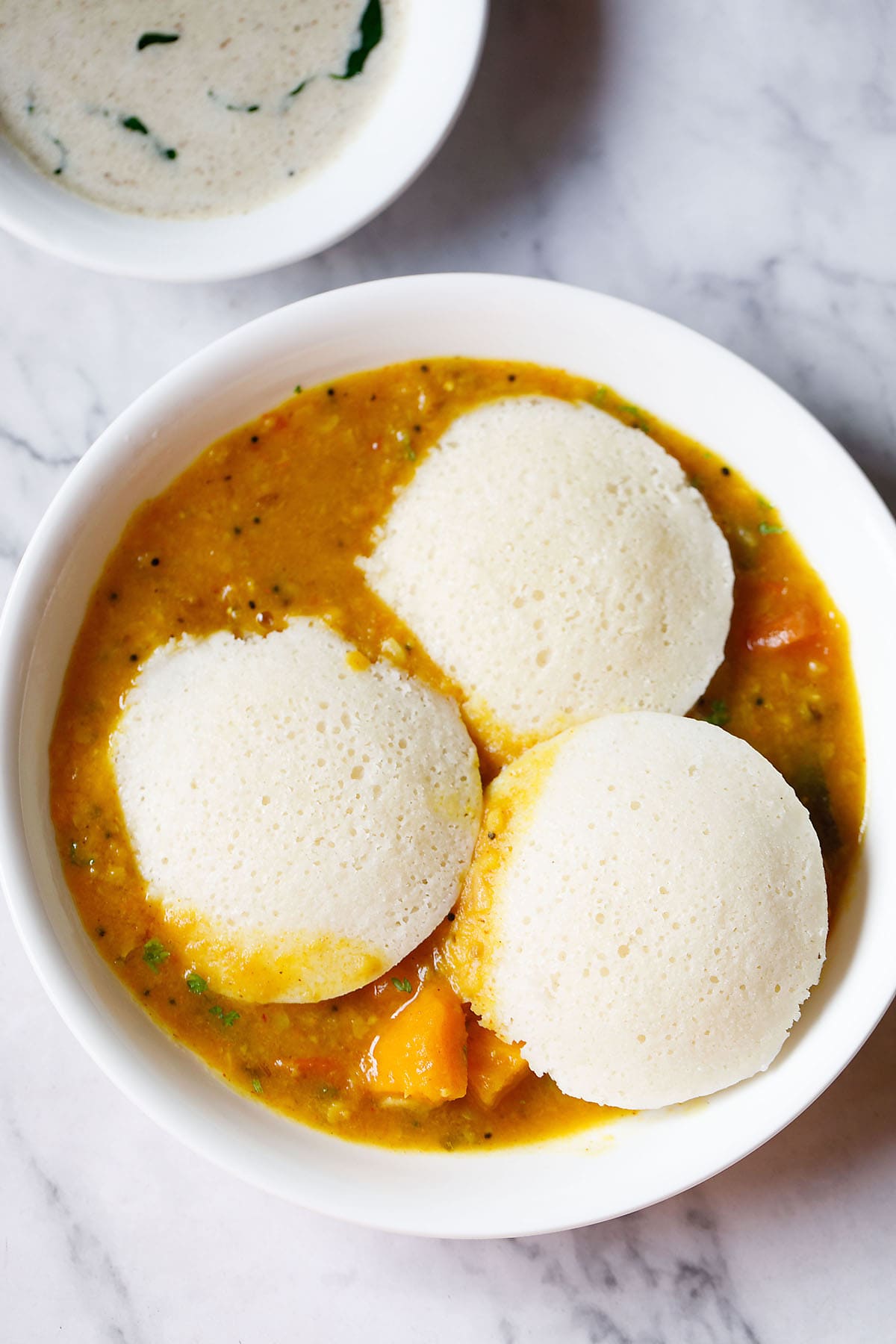

Delicate Idli Made the Conventional Method
Idli isn’t simply meals — it’s a reminiscence. Rising up, Sundays at residence meant the comforting rhythm of idli-making. My mother would soak rice and urad dal in the course of the day, and by night time, the acquainted whirr of our outdated Sumeet mixer would fill the kitchen as she floor the batter.
I nonetheless do not forget that earthy aroma of freshly floor urad dal — so distinct, so comforting. Even at this time, after I put together the batter, I’m immediately transported again to these evenings, watching her pour the thick batter into a big bowl, gently mixing in salt, and setting it apart to ferment in a single day.
Sunday breakfast was all the time a celebration of sentimental, steaming sizzling idlis; typically adopted by crisp dosas from the identical batter. Any leftovers would magically flip into scrumptious uttapams or paniyarams the subsequent day.
It was easy, soulful meals made with love; a rhythm I proceed in my very own kitchen at this time. Together with these recollections, this recipe brings collectively time-tested approach and cautious fermentation so your idlis prove comfortable and fluffy each time.
Idli is my consolation meals – easy, nourishing, and timeless. Naturally vegan, gluten-free, and lightweight on the abdomen, it’s additionally one of many healthiest breakfast choices round. This traditional South Indian dish has discovered followers not simply throughout India, however around the globe.
Idli is a comfortable, steamed savory cake constructed from a naturally fermented batter of parboiled rice and urad dal (hulled black gram). It’s a staple South Indian breakfast identified for being mild, nutritious, vegan, and gluten-free.
The method entails soaking rice, fenugreek seeds and lentils, grinding them right into a nice, thick batter, fermenting it in a single day or for 8 to 9 hours, after which steaming the batter in idli moulds. The result’s a fluffy, spongy, and mildly tangy idli that pairs fantastically with coconut chutney and sambar.
This submit walks you thru the normal method of constructing idli with rice – so you’ll be able to recreate the identical comfortable idlis I grew up consuming.
Overview of the Idli Making Course of
Making idli the normal method entails 4 key steps: soaking, grinding, fermenting, and steaming. Whereas there are shortcuts out there at this time, nothing fairly matches the comfortable texture and lightweight tang of a correctly fermented home made batter.
There are two time-tested approaches: one utilizing idli rice, and the opposite utilizing idli rava. Each yield wonderful outcomes and comply with the identical foundational methodology.
1. Idli with Rice and Urad Dal
This traditional model makes use of idli rice paired with hulled urad dal (black gram). Idli rice refers to parboiled rice, historically utilized in making comfortable idlis.
You need to use both complete or cut up urad dal. Each work effectively so long as they’re contemporary. Aged lentils don’t ferment correctly and may result in dense idlis.
Some residence cooks use short-grain styles of uncooked rice like parmal rice or sona masuri rice, which additionally give a comfortable texture. The batter is floor to a nice consistency and combined with salt earlier than fermenting.
2. Idli with Idli Rava
A barely simpler methodology makes use of idli rava, which is coarsely floor parboiled rice. It skips the rice grinding step, making it faster whereas nonetheless producing comfortable, fluffy idlis. Simply soak the rava and urad dal individually, then grind solely the dal earlier than mixing and fermenting.
Soaking, Grinding & Fermentation Suggestions
Every stage performs a task in getting good idlis — comfortable, spongy, and lightweight.
1. Soaking Suggestions
Rinse each rice and dal effectively and soak individually for 4 to five hours. Use contemporary urad dal for greatest fermentation. Poor-quality or aged dal usually ends in chewy, flat idlis.
2. Grinding Strategies
a) Stone Grinder: Ultimate for big batches. Produces fluffier batter with higher fermentation. Add water step by step — round 1 cup for ½ cup urad dal and 1.5 to 2 cups for two cups soaked rice.
b) Mixer Grinder (Mixie): Good for small batches. A very good mixie or high-speed blender like Vitamix does the job effectively with cautious approach.
Personally, I typically use the stone grinder for bigger portions and the mixie for on a regular basis batches. Each strategies work splendidly whenever you use the proper ratios and permit correct fermentation time.
3. Fermenting the Batter
As soon as floor, combine the rice and dal batters completely. Cowl and go away to ferment for 8 to 12 hours or in a single day in a heat place. A well-fermented batter will double (and even triple) in quantity and have a mildly bitter aroma – good for idli.
The fermentation of idli batter occurs naturally attributable to wild yeast and lactic acid micro organism current on the rice and urad dal. As they multiply, they launch gases and acids that assist the batter rise, giving idlis their signature comfortable and spongy texture.
4. Steaming the Good Idlis
Idlis are steamed in greased idli moulds positioned in a steamer or strain cooker (with out the load/whistle). Spoon the batter into moulds and steam till set.
The idlis must be steamed for 12 to fifteen minutes; keep away from over-steaming as it may possibly make them dry or dense. To verify doneness, insert a toothpick — it ought to come out clear.
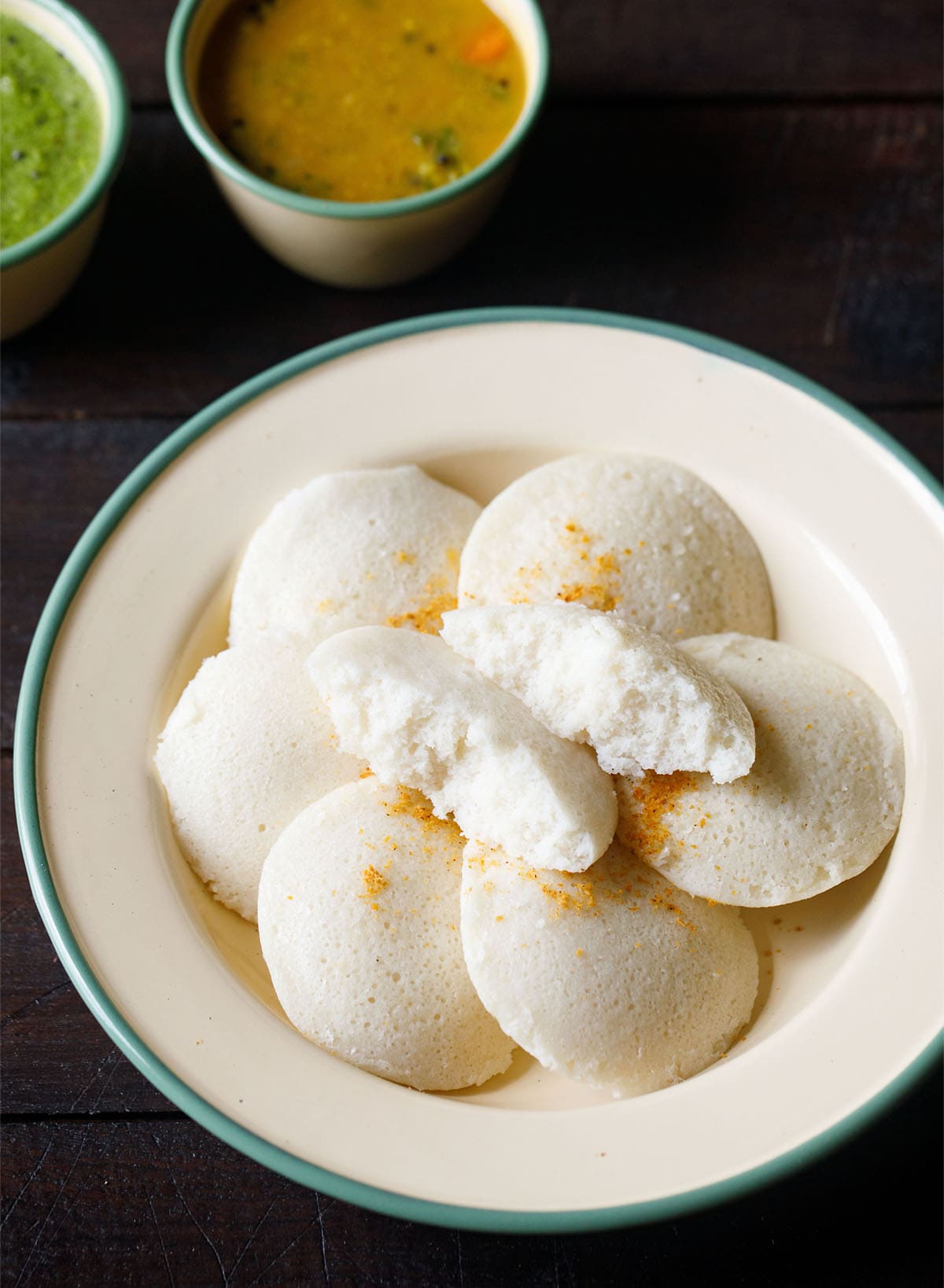

Step-by-Step Information
Easy methods to Put together Conventional Idli at Dwelling
Soak the Rice, Lentils & Poha
1. In a bowl or pan take 1 cup parboiled rice and 1 cup common rice. Right here I’ve used the Indian number of sona masuri rice together with parboiled rice.
As an alternative of this proportion, you too can use general 2 cups of idli rice OR 2 cups of parboiled rice (as proven within the video above).
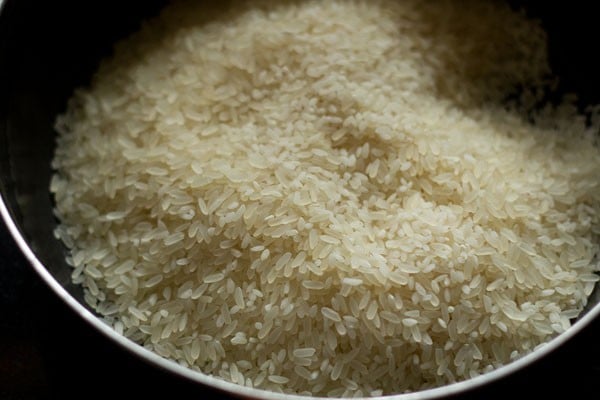

2. Choose after which rinse each the rice varieties a few instances in contemporary water. Drain all of the water and hold it apart.
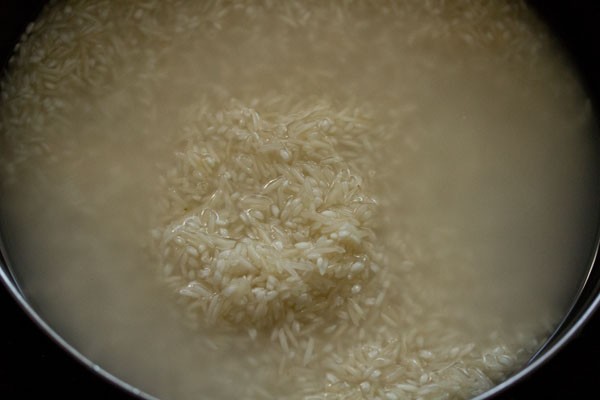

3. Take ¼ cup thick poha (flattened rice or parched rice) in a bowl. Poha helps in making the idli comfortable and fluffy. If you happen to don’t have poha then you’ll be able to skip it.
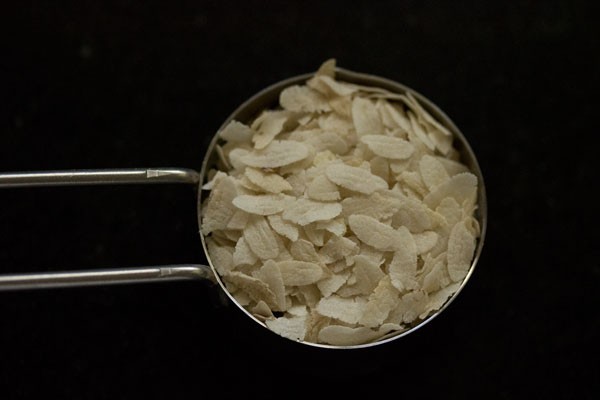

4. Rinse the poha a few times with contemporary water.
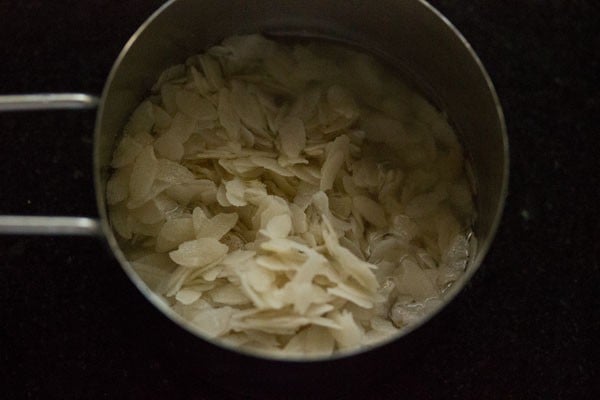

5. Then add the poha to the rice. Add 2 cups of water. Combine very effectively and hold apart lined to soak for 4 to five hours.
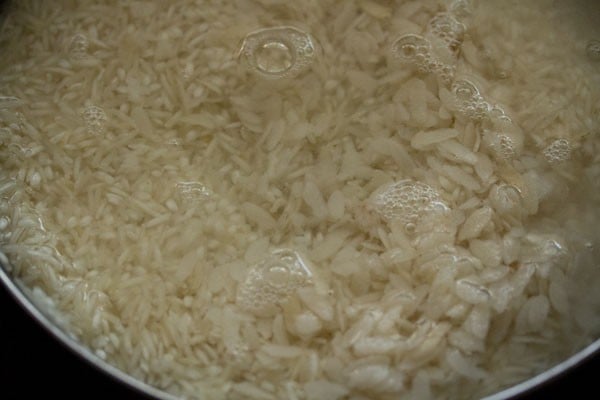

6. In a separate bowl take ½ cup urad dal (husked black gram) together with ¼ teaspoon fenugreek seeds.
Omit the fenugreek seeds in case you don’t have them.
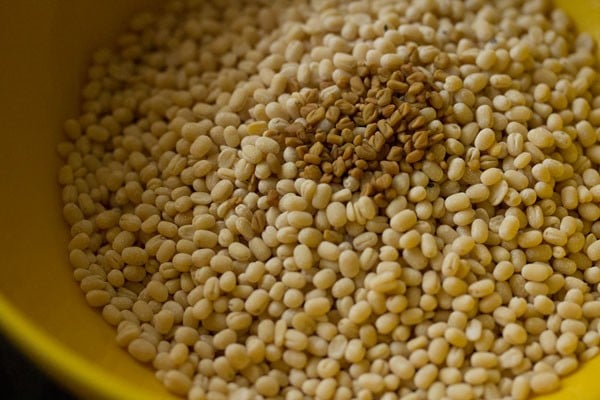

7. Rinse a few instances in contemporary water.
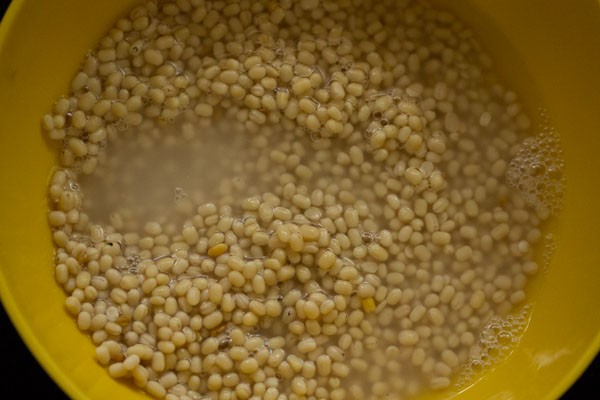

8. Add 1 cup water. Cowl and soak for 4 to five hours.
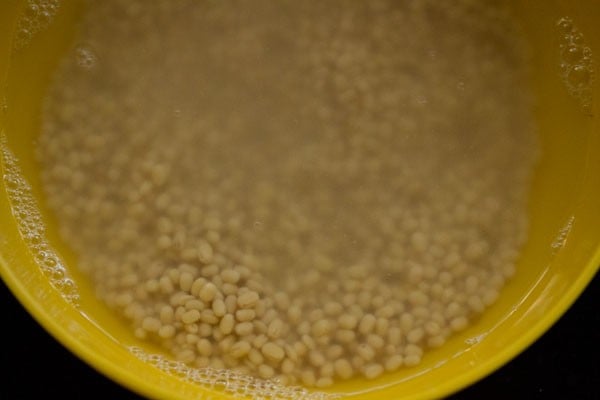

9. Earlier than grinding, drain the water from urad dal, however don’t throw away the water. Reserve the soaked water as we can be utilizing this water for grinding or you should use contemporary water for grinding.
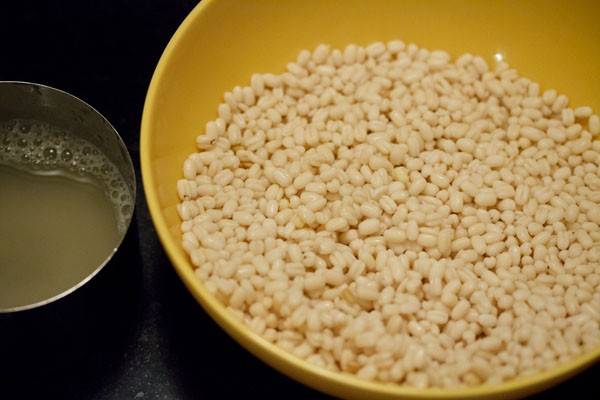

Grind Rice and Urad Dal Individually
10. In a moist grinder jar, add the urad dal. Initially add ¼ cup of the reserved water or contemporary water.
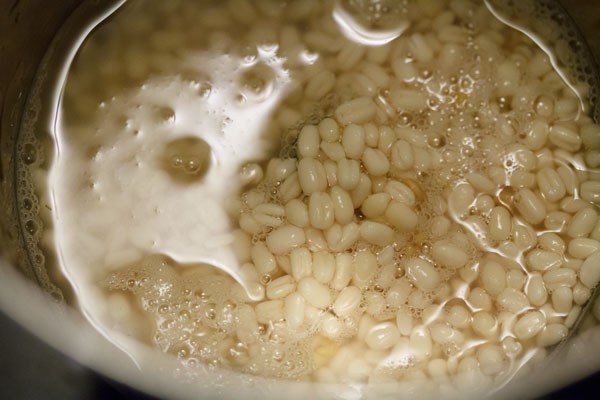

11. And grind the urad dal for some seconds. Then add ¼ cup of the reserved soaked water or contemporary water and proceed to grind. The batter must be mild and fluffy when utterly floor.
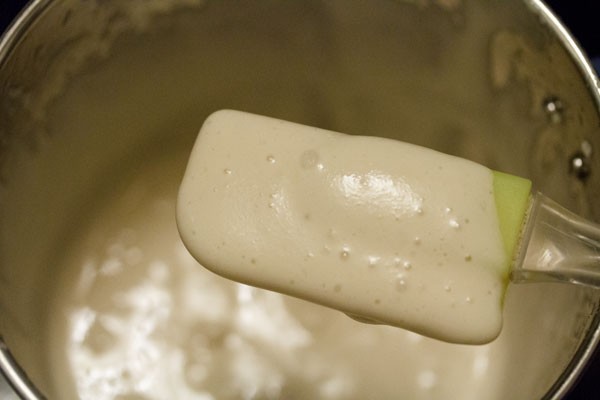

12: Pour the urad dal batter in a deep pan or bowl.
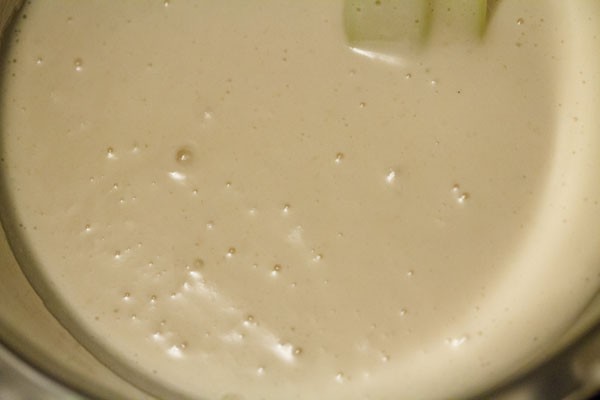

13: Drain the water from the rice and poha. Add them within the moist grinder jar or in a robust blender. I often grind in two batches.
Relying on the capability of your mixer-grinder or blender you’ll be able to grind in two to 3 batches. If the mixie will get heated up whereas grinding, then cease and let it cool. Then proceed with the grinding.
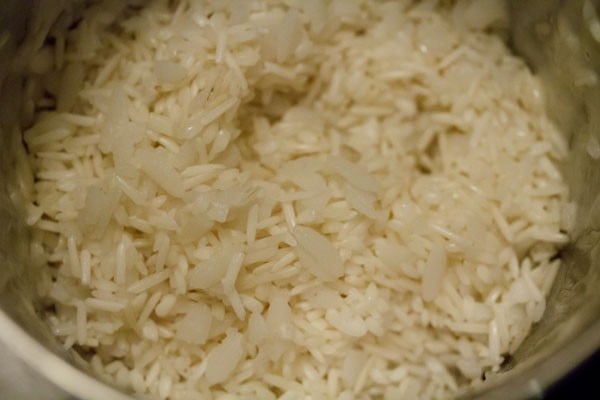

14: Use the reserved urad dal strained water or common contemporary water to grind the rice and poha too. Add water in elements and grind.
The rice can have a nice rava like consistency within the batter. A easy batter can be nice. I often add a complete of ¾ cup of water whereas grinding rice. The rice batter shouldn’t be too thick or skinny.
You may add about ¾ to 1 cup of water relying upon the standard of rice.
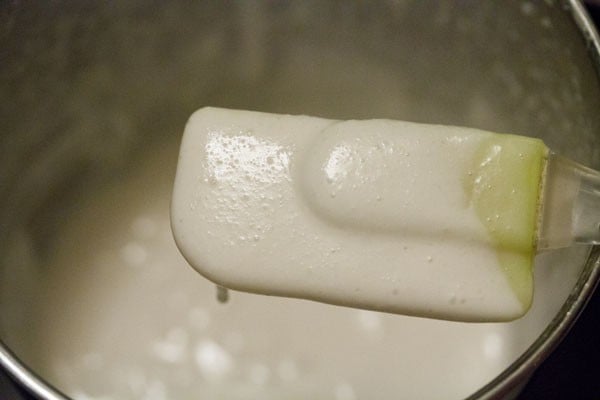

15: Now pour the rice batter within the bowl containing the urad dal batter.
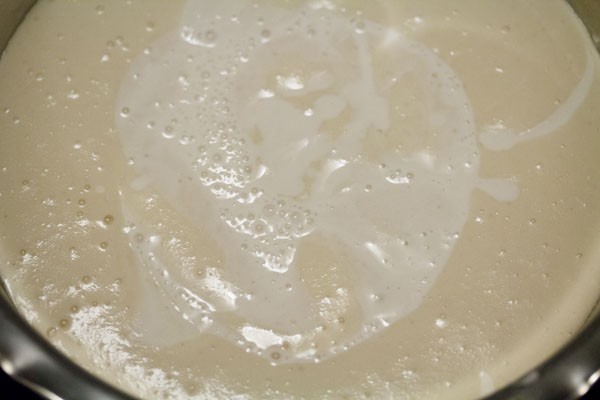

16. Add 1 teaspoon of edible rock salt or pink salt. Combine very effectively with a spoon or spatula. If you happen to dwell in a cool or chilly area, then don’t add salt. Add salt later as soon as the fermentation is finished.
If you happen to dwell in a sizzling or heat local weather, then add salt because it doesn’t enable the batter to recover from fermented within the time period of 6 to eight hours.
Observe that salt retards the fermentation course of.
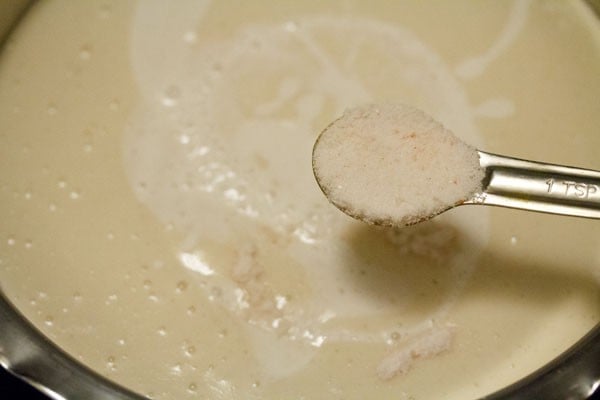

Let the Batter Ferment Naturally
17. Cowl the bowl or container with a lid and hold the batter in a heat place. It must be left undisturbed for 8 to 9 hours. Don’t use an air-tight lid. In colder local weather, hold the batter for an extended time – from 12 to 24 hours.
I’ve talked about numerous ideas beneath for the idli batter to ferment effectively. So do learn this part beneath after step-by-step images.
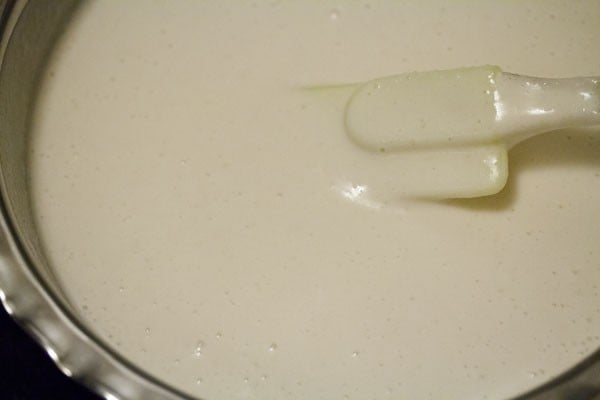

18. The batter the subsequent morning. It should ferment and enhance in quantity. A effectively fermented idli batter can have a pleasant bitter aroma with many tiny air pockets within the batter.
As quickly because the batter is fermented you’ll be able to start with steaming the idli or hold the batter within the fridge if making later.
If you happen to enable the fermented batter to stay at room temperature, it’s going to ferment extra and can turn into very bitter with time.
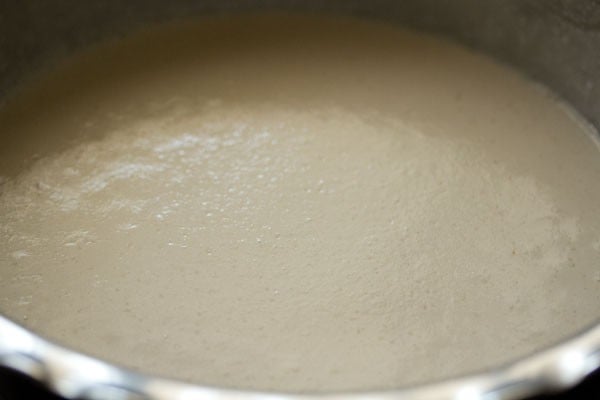

Steam the Idli to Perfection
19. Grease or brush the idli mould with oil throughout evenly. Gently and evenly swirl the batter. Don’t overdo. Now with a spoon pour parts of the batter within the greased idli moulds.
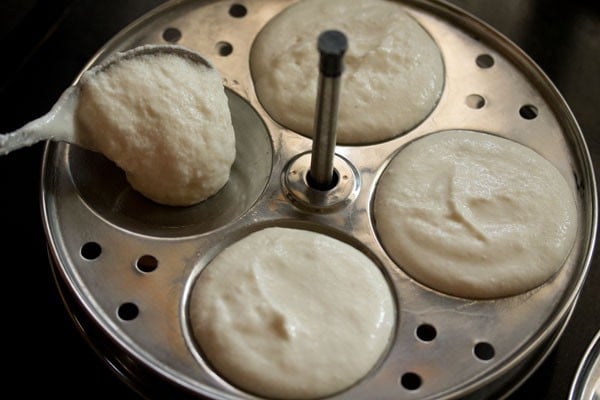

20. Take your idli steamer or strain cooker or electrical cooker or On the spot pot. Add some 2 to 2.5 cups water and warmth the water till it involves a lightweight boil. Maintain the idli mould within the steamer or strain cooker. Steam for 12 to fifteen minutes.
Timing will range relying on the type of tools you might have used. If utilizing a strain cooker, then cowl the strain cooker with its lid. Take away the vent weight/whistle from the lid. Steam the idlis for approx 12 to fifteen minutes.
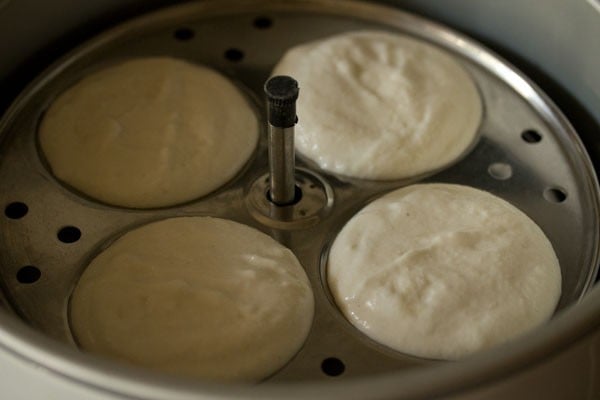

21. Test for doneness by fastidiously inserting a bamboo skewer or knife. If it doesn’t come out clear, then hold once more for a couple of extra minutes.
When executed take away the idli mould from the cooker. Don’t overcook as then they turn into dry.
Dip a spoon or butter knife in water and slid them by the idlis. Take away and place the idlis in a heat container like a casserole.
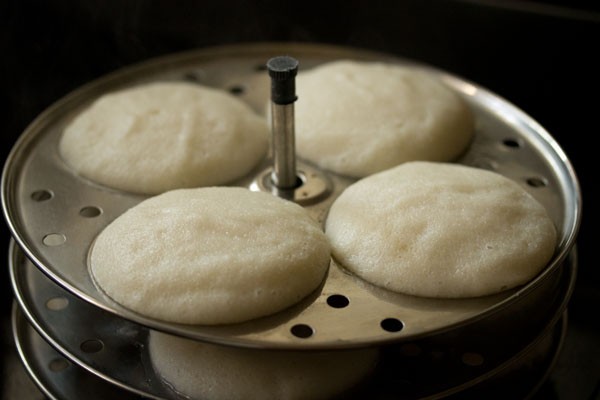

22. Serve Idli sizzling or heat with sambar and coconut chutney.
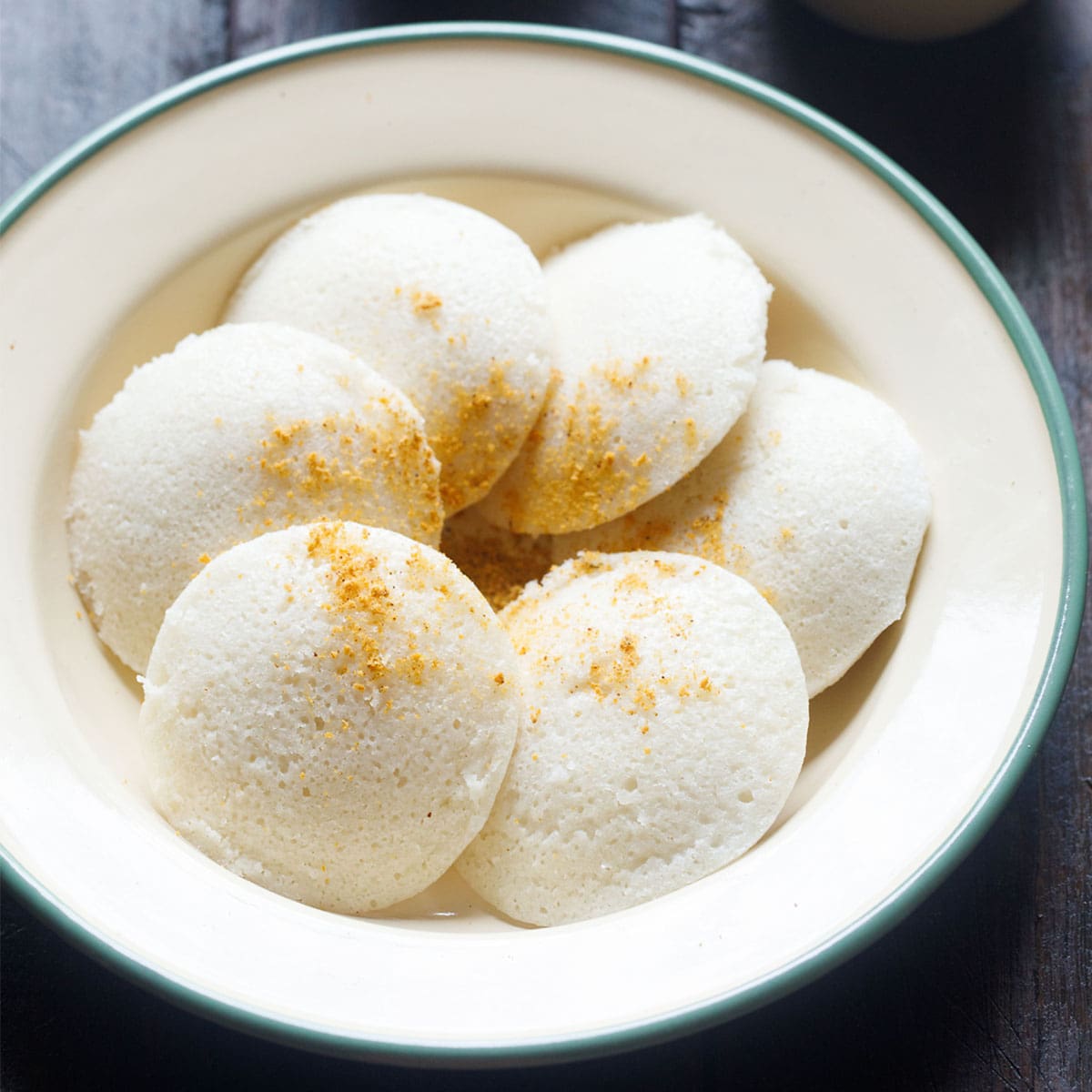

What to Pair With Idli
- Idli is mostly served with coconut chutney and sambar, a traditional pairing that brings out its comfortable, delicate taste. Historically, idli is dunked in sizzling sambar and eaten with beneficiant spoonfuls of chutney on the facet.
- There are a lot of variations of each sambar and chutney you’ll be able to attempt; from thick hotel-style Tiffin Sambar to thinner, homestyle variations.
- You may as well serve idli with chutneys like Onion Chutney, Tomato Chutney, or Peanut Chutney for selection.
- One other scrumptious and fast accompaniment is Idli Podi – a dry lentil-based spice combine usually combined with ghee or sesame oil.
- If you happen to’re brief on time, a easy plate of idli with coconut chutney and podi is simply as satisfying. In some properties, idli is served with tempered and spiced curd, making for a comforting mixture.
Storing Idli and Batter the Proper Method
Leftover idlis might be saved within the fridge for as much as 2 days. Place them in an hermetic container and reheat by steaming or microwaving with a sprinkle of water to carry again their softness.
Idli batter retains effectively within the fridge for 3 to 4 days. Retailer it in a lined container and produce it to room temperature earlier than utilizing. Stir the batter gently earlier than making idlis, as this helps retain the air bubbles shaped throughout fermentation.
If you happen to’d wish to retailer the batter longer, it may be frozen for as much as 1 month. Use hermetic, freezer-safe containers and go away some house for the batter to broaden.
Thaw the batter in a single day within the fridge or at room temperature earlier than use. Remember the fact that frozen batter could yield barely much less ethereal idlis in comparison with freshly fermented batter.
Artistic Variations You Can Attempt With the Batter
When you grasp the essential idli batter, there are infinite methods to make it your individual. You may add lentils like moong dal to create Moong Dal Idli, or mix in millets and millet flours for a extra healthful twist. I additionally embody thick poha to make the extremely comfortable and fluffy Poha Idli.
If you happen to’re on the lookout for more healthy or gluten-free choices, including millets like ragi (verify my Ragi Idli) or different millets works very effectively.
Even oats might be included within the batter for added fiber. I’ve shared an Fast Oats Idli recipe on the weblog that’s good for busy mornings. You may as well take a look at this Millet Idli made with foxtail millet for a lightweight and nutritious choice.
You might also get pleasure from exploring these distinctive regional and artistic takes:
- Kanchipuram Idli – Spiced and steamed in banana leaves, this Tamil Nadu-style idli is flavored with cumin, pepper, ginger, and ghee.
- Thatte Idli – A big, flat idli from Karnataka that’s comfortable, spongy, and ideal for dunking in sambar.
- Leftover Rice Idli – An effective way to make use of cooked rice, these idlis are comfortable, fluffy, and wish fermentation.
- Sama Chawal Idli – Made with barnyard millet (sama), these idlis are perfect for fasting days or gluten-free diets.
- Kotte Kadubu – A conventional Karnataka recipe the place idlis are steamed in jackfruit leaves for a definite taste and aroma.
Finally, don’t be afraid to experiment. Attempt completely different proportions, additions, and strategies to find what provides you the perfect texture, style, and fermentation in your individual kitchen.
Knowledgeable Suggestions
Like I’ve talked about above Idli was a weekend ritual rising up. Each Sunday meant sizzling idlis or comfortable dosas with chutney and sambar. After I first began making them myself, it took some trial and error, however I finally realized what works.
- Including Poha: Add a handful of thick poha or cooked rice to the batter for a softer texture. This step is non-obligatory however makes a noticeable distinction.
- Steaming in Muslin: Decide to steam idlis on a damp muslin fabric for a easy, comfortable floor.
- Fermentation: Make sure the batter ferments effectively, with a pleasing, mildly bitter aroma and visual rise.
- Rice Kind: Use idli rice or an equal mixture of parboiled rice (idli rice) and uncooked rice for greatest outcomes.
- Lentil Freshness: All the time use contemporary urad dal; aged lentils can result in dense idlis.
- Water Proportion: The quantity of water must be good in your batter. Neither much less nor extra. Goal for the proper steadiness.
- Multipurpose Batter: The batter is versatile – make idli on day one, and dosa, uttapam, or appe on the next day.
Fermentation Assist – Easy methods to Repair Batter That Received’t Rise
Fermentation is a key consider getting comfortable, mild and fluffy idli. For correct fermentation of idli batter a heat temperature is apt. In chilly climates, fermentation doesn’t occur effectively.
I get a number of queries on the right way to ferment idli or dosa batter in winters. So I’ve summarized my experiences within the following factors beneath:
- Maintain the batter heat: Fermentation wants heat. In winter or chilly climates, place the batter close to a heater, in a switched-off oven preheated barely, or inside an On the spot Pot utilizing the yogurt mode on the ‘much less’ setting.
- Keep away from salt throughout fermentation in winter: Salt slows down fermentation, particularly in colder temperatures. Add it solely after the batter has risen.
- Add a pinch of sugar or use fenugreek seeds: Sugar helps kickstart fermentation. Soaking fenugreek seeds with urad dal helps the batter ferment higher and quicker by boosting the pure good micro organism and yeast, which additionally makes the batter rise effectively and provides it a greater texture.
- If the batter hasn’t risen in any respect: After 12 to 14 hours, if there’s no rise and it’s nonetheless chilly, stir in ¼ to ½ teaspoon of prompt yeast dissolved in a little bit of water. Use the batter instantly and don’t refrigerate it, as it’s going to turn into too bitter.
- As a final resort, add baking soda: A small quantity (¼ to ½ teaspoon) of baking soda might be added earlier than steaming, however use this provided that fermentation utterly fails.
- Test your urad dal batter: The urad dal should be floor till very fluffy and lightweight. This helps the whole batter rise higher.
- Water ratio issues: Don’t use too little water, as it may possibly result in a thick, dense batter that doesn’t ferment correctly.
- Use an On the spot Pot in very chilly climates: Place a small trivet within the On the spot Pot metal insert, set the batter bowl on it, and ferment utilizing the yogurt setting. Maintain the vent on venting or use a glass lid. In heat climate, this will take 7 to eight hours; in winter, it may possibly take longer.
Idli Batter vs Dosa Batter – What’s the Distinction?
Although each are constructed from the identical elements, idli and dosa batters have key variations. Idli batter is thicker in consistency and desires to carry its form when poured into moulds.
Dosa batter, alternatively, must be barely thinner so it spreads simply on a sizzling tawa/griddle. For idli, I often comply with a 4:1 ratio of rice to urad dal. For dosa, a 3:1 ratio works effectively.
Apparently, you should use the identical 4:1 idli batter to make dosa; simply skinny it barely with water after fermentation.
This versatility is what makes the idli-dosa batter a real staple in South Indian kitchens. You may as well swap in sona masuri or parmal rice for dosa, and even use idli rava as an alternative of rice.
Leftover idlis are good for fast snacks or lunchbox recipes. Listed below are some artistic and engaging methods to make use of them:
- Fried Idli: Shallow-fry or deep-fry leftover idlis till golden and crisp. Serve with chutney or ketchup for a crunchy snack.
- Masala Idli: Dice the idlis and sauté them in a spicy onion-tomato masala with curry leaves and spices.
- Idli Upma: Crumble the idlis and sauté with mustard seeds, inexperienced chilies, curry leaves, and onions for a fast and satisfying dish.
- Chilli Idli: Stir-fry cubed idlis with capsicum, onion, soy sauce, and inexperienced chilies for a desi-Chinese language twist.
- Podi Idli: Toss heat idlis in a mix of idli podi and sesame oil or ghee for a spicy, flavorful snack.
- Idli Manchurian: Pan-fry idli items and coat them in a candy, tangy Manchurian sauce – good as an Indo-Chinese language appetizer.
Your Idli Questions Answered
Nicely-fermented idli batter ought to double in quantity, have a gentle bitter aroma, and present small air bubbles all through. It should really feel lighter when stirred and look barely risen and ethereal on high.
This often occurs when the urad dal isn’t floor fluffy sufficient or the batter is just too thick. Be sure to grind the urad dal until very mild and ethereal. Additionally, don’t skimp on soaking time or heat throughout fermentation.
Sure, you may make idli with out poha (flattened rice). Nevertheless, poha or a little bit of cooked rice helps in giving the idlis a extra softer texture. If you happen to skip it, be sure your fermentation is robust and batter consistency is ideal.
If the batter hasn’t fermented after 12 to 14 hours, and the temperature is chilly, you’ll be able to stir in a small quantity of prompt yeast or baking soda simply earlier than steaming. However solely do that if completely mandatory, and use the batter instantly.
If you happen to’ve tried this recipe, please charge it within the recipe card or go away a remark beneath – I’d love to listen to your suggestions. For extra vegetarian inspiration, join my electronic mail updates or comply with me on Instagram, Youtube, Fb, Pinterest or X.
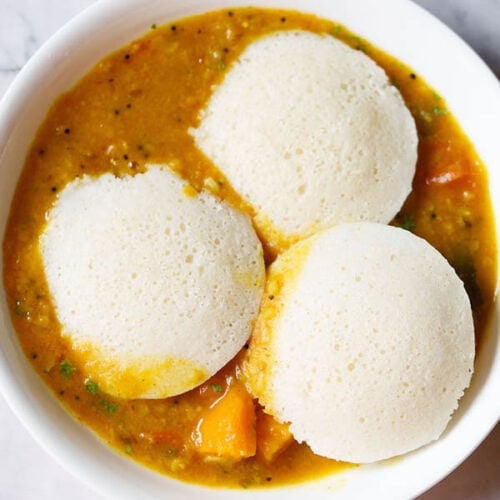

Idli Recipe (Conventional South Indian)
Idli is a traditional South Indian breakfast dish ready from a fermented batter of parboiled rice and urad dal (hulled black gram), steamed into comfortable, ethereal, and spongy muffins. It’s generally loved with coconut chutney and sambar, making for a nutritious and satisfying meal. Idli is a well-liked Indian breakfast which is filling in addition to nutritious.
Prep Time 9 hours
Prepare dinner Time 25 minutes
Whole Time 9 hours 25 minutes
Stop your display screen from going darkish whereas making the recipe
Soaking rice and lentils
Choose and rinse each the common rice and parboiled rice.
Rinse the poha and add to the rice.
Add water. Combine effectively. Cowl and hold the rice + poha to soak for 4 to five hours.
In a separate bowl, rinse the urad dal and methi seeds a few instances.
Soak the urad dal with methi seeds individually in water for 4 to five hours.
Making idli batter
Drain the soaked urad dal. Reserve the water.
Grind the urad dal, methi seed with ¼ cup of the reserved water for some seconds. Then add remaining ¼ cup water. Grind until you get a easy and fluffy batter.
Take away the urad dal batter in a bowl and hold apart.
Grind the rice in batches to make a easy batter.
Combine each the batters collectively in a big bowl or pan. Add salt and blend effectively.
Cowl and let the batter ferment for 8 to 9 hours or extra if required.
After the fermentation course of is over, the idli batter will turn into double in measurement and rise.
Making idli
Grease or brush the idli moulds evenly with oil.
Pour the batter within the moulds and steam the idli in a strain cooker or steamer.
If utilizing strain cooker take away the vent weight (whistle).
Steam for 12 to fifteen minutes or till the idli is finished.
Serve the steaming sizzling idli with coconut chutney and sambar.
Remaining batter might be saved within the fridge for a few days.
- For normal rice selection – you should use sona masuri rice or parmal rice or basmati rice.
- Observe that the approximate diet information is for 1 medium-sized idli served as is with out chutney or sambar.
-
Fermentation is likely one of the foremost elements to get comfortable, mild and fluffy idli. Fermentations ideas for winters listed beneath.
- Heat: Place the idli batter bowl in a heat place – e.g close to a heater or in a heat place in your kitchen.
- Oven: Preheat your oven at a low temperature (80 to 90 levels celsius) for about 10 to fifteen minutes. Then swap off the oven, hold the batter bowl inside and shut the door.
- Lights within the oven: In case your oven has lights, then hold the lights on and place the batter inside.
- Sugar: Including a little bit of sugar does assist in fermenting the batter. On this recipe you’ll be able to simply add upto 1 teaspoon sugar and don’t fear – the idli gained’t be candy.
- Salt: Throughout winters, skip including salt to the idly batter as salt retards the fermentation course of. Rock salt and sea salt are good choices so as to add within the idli batter.
- Fermentation time in chilly winters: In winters, hold the batter for an extended time to ferment, like 14 to 24 hours or extra. Do do not forget that even when you don’t see the batter doubled or tripled, you need to see tiny bubbles within the batter. You must also get the standard faint bitter fermented aroma from the idli batter.
- On the spot Yeast: You may even add ¼ to ½ tsp of prompt yeast (dissolved in 2 to three teaspoons of water) 30 to 45 minutes earlier than you steam the idli. However do that methodology when the batter has not fermented effectively. The negatives of this methodology is that you need to use all of the batter directly. Even refrigerating this batter makes it very yeasty and bitter.
- Baking Soda: You may as well add ¼ to ½ baking soda after which ferment the batter in chilly seasons.
- Fenugreek seeds: Addition of fenugreek seeds (methi seeds) additionally helps in fermentation.
- Urad dal batter consistency: Urad dal needs to be floor rather well. Urad dal batter needs to be comfortable, mild and fluffy. So I recommend to grind each urad dal and rice individually to get comfortable and fluffy idli. A effectively floor urad dal batter additionally helps in fermentation. Additionally use urad dal which is contemporary and inside its shelf-life. Aged urad dal doesn’t ferment effectively and makes the idli dense.
- Quantity of water: Do keep in mind so as to add the correct quantity of water within the batter. If the water is much less, then the idli will turn into dense.
- Fermenting idli batter in On the spot Pot: Press the yogurt choice and use the much less mode. Place a small trivet within the IP metal insert. Maintain the bowl with the batter on the trivet. Maintain the vent place to venting or you should use the On the spot Pot glass lid. Set the time for 7 to eight hours. On hotter days, the batter will ferment rapidly. On colder days, it might take a couple of extra hours for the batter to ferment within the On the spot Pot.
Diet Details
Idli Recipe (Conventional South Indian)
Quantity Per Serving
Energy 38 Energy from Fats 9
% Every day Worth*
Fats 1g2%
Saturated Fats 1g6%
Sodium 81mg4%
Potassium 9mg0%
Carbohydrates 8g3%
Fiber 1g4%
Sugar 1g1%
Protein 1g2%
Vitamin B1 (Thiamine) 1mg67%
Vitamin B2 (Riboflavin) 1mg59%
Vitamin B3 (Niacin) 1mg5%
Vitamin B6 1mg50%
Vitamin C 1mg1%
Vitamin E 1mg7%
Calcium 5mg1%
Vitamin B9 (Folate) 1µg0%
Iron 1mg6%
Magnesium 2mg1%
Phosphorus 9mg1%
Zinc 1mg7%
* P.c Every day Values are primarily based on a 2000 calorie weight loss program.
Idli Recipe from the archives was first revealed on April 2012.

